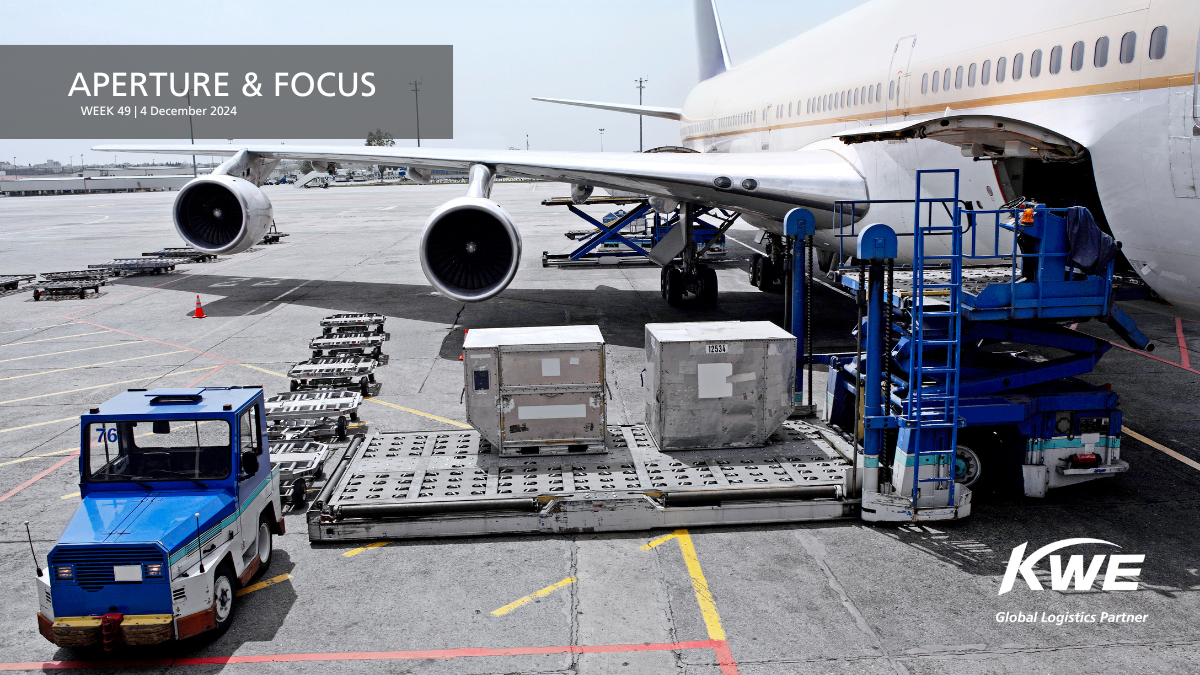Quote
Aperture & Focus 2024: Week 49

Global Aperture
Air cargo volumes showed robust growth in October, marking a 15th consecutive month of year-on-year increases, with global demand rising 9.8% and capacity up 5.9%, according to IATA. However, while 2024 prospects remain positive, IATA urges caution for 2025 amid potential geopolitical disruptions, including tariffs that could impact global supply chains.
Despite these potential changes, the airfreight industry remains optimistic for a strong start to the year, driven by e-commerce growth and stockpiling ahead of tariff hikes. In the medium term, a shift in production from China to Southeast Asia is expected to avoid tariffs, with increased exports of raw materials from China to new manufacturing hubs.
Regional Focus
Americas
United States: The ongoing dockworker dispute over automation at United States east and Gulf coast ports is nearing a breaking point, with both sides unable to reach an agreement. The International Longshoremen's Association (ILA) union strongly opposes United States Maritime Alliance (USMX)’s push for more semi-automated equipment, citing job losses and national security concerns, particularly the risk of cyberattacks on automated systems. Forwarders are increasingly worried that if no deal is struck by the January 15th deadline, a prolonged strike could cause significant disruptions to global shipping and logistics.
Mexico: Shippers are rushing to transport goods from Mexico to the US ahead of Chinese New Year in January, driven by strong demand and the need to avoid potential delays. Mexico is increasingly becoming a key production base due to near-shoring, with many companies relocating operations closer to the US. As a result, the shipping of semi-finished products, particularly from South Korea, is expected to rise significantly into the new year, reflecting the growing importance of the region in global supply chains.
Asia-Pacific
India: Indian air cargo volumes are expected to quadruple over the next two decades, driven by rising ecommerce demand and expanding manufacturing. The country's growing ecommerce sector, along with government investments in aviation infrastructure, is strengthening its air freight industry as India's freighter fleet expands to meet the expected growth.
Hong Kong: Hong Kong International Airport celebrated the launch of its three-runway system and new airport center, which will boost cargo handling capacity to 10 million tons annually and accommodate 120 million passengers. The project, which began in 2016, includes expanded infrastructure, and Cathay Pacific plans to increase flights as part of its HK$100bn investment, aiming to strengthen Hong Kong's position as a leading global aviation hub.
China: Shippers in China are increasingly looking to South America for manufacturing, as near-shoring trends grow and the threat of tariffs on China exacerbates the shift. Miami is emerging as a key hub due to its strong connectivity to Latin America, with rising cargo volumes and increased capacity, although the demand still faces pressure from a capacity crunch.
Europe, Middle East & Africa
Europe’s road freight industry is facing a severe driver shortage, with around half a million vacancies, representing 12% of all positions. The situation is expected to worsen next year due to an aging workforce, with the shortage potentially growing to 15%, while efforts to recruit more female, younger, and non-European drivers are being explored to address the gap.
United Kingdom: The UK Emissions Trading Scheme (ETS) Authority is proposing to include maritime transport in its carbon trading system, as part of its drive toward net-zero emissions by 2050. A consultation is underway to shape the plan, which aims to encourage investment in clean technologies and expand carbon capture initiatives, while addressing regional and international considerations.